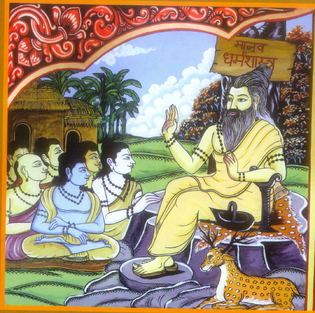Dharmashastras (धर्मशास्त्राणि)
| This article needs editing.
Add and improvise the content from reliable sources. |
Dharmashastras (Samskrit : धर्मशास्त्राणि) are the texts that have discussed the dharmas extensively in a comprehensive manner. Unlike the Vedas which have short incidental statements and references to dharmas, these voluminous books deal with socio-economic, moral and judicial aspects in an organized manner drawing their reference from Vedas.
They address many aspects unique to Sanatana Dharma such as Samskaras, Shaucha, Prayaschitta, Shraddha, Srtidharma and many others. Apart from Vedas, the Kalpa Sutra works (Shrauta, Grhya and Dharmasutras), Smrtis, Itihasas and Puranas included under Vaidika Vangmaya have greatly influenced the development of Dharmashastras.
The time of composition of Dharmashastras is beyond the scope of discussion of this article.
Introduction
Dharmashastra works are related to the society and are bound to display changes and modifications in the traditions as we see them from dharmas in Shrutis to Nibandhas. The conduct of man has reference to his surroundings as well as to himself. The concept of "two sides of a coin" such as right and wrong, the good and bad, love and hate etc all depend upon the scheme of evolution of the beings and cannot be described independently of that scheme. Thus the determination of what is right or good has to be done carefully for the higher good of existence and not just individuals or a class of beings. Any such judgement has to be in congruity with the general goal of human evolution. Reference to many such details have been supplied to us by the rshis and maharshis, who have not only left the scheme of evolution of our world systems, but also have left to us the general rules for dealing with human, other forms of life as well as inanimate things.[1]
For instance, the dharmas for the four Ashramas refer to the facts and laws of individual evolution; and the dharmas for the four Varnas deal with the facts and laws of human evolution at large, including those about laws for ruling the states, division of labour and social organization. The conditions of the Ashramas and Varnas exhaust all possible situations in the whole life of the present day humanity, thus many rules of Sanatana Dharma are applicable in modern day socio-economic situations.
It is debated by many that such Varna Ashrama dharmas are not existent in other nations and are different. On close observation it can be said that though not expressly recognized, the divisions themselves are to be found everywhere, under other names, in all the races of the present day. The natural conditions of the present evolution unavoidably force upon humanity the relations of teacher and student, ruler and ruled, producer and consumer, master and servant, parent and son or daughter, husband and wife, brother and sister, worker and pensioner, employer and employee, soldier and civilian, agriculturist and tradesman, householder and a recluse and many such other. The Sanatana Dharma, instead of leaving these relations to vague and groping experiments, rationally orders and systematizes them. These dharmashastras teach general and specific duties and virtues proper to each relation and situation, with the injunction that they should never be mixed up together indiscriminately, great is the danger in doing so as said in Bhagavadgita.[1]
श्रेयान्स्वधर्मो विगुण: परधर्मात्स्वनुष्ठितात् | स्वधर्मे निधनं श्रेय: परधर्मो भयावह: || 35|| (Bhag. Gita. 3.35)
It is indeed better to perform one's natural prescribed dharma, even with faults, than follow the dharma of another perfectly. It is better to die (in the performance of) one's own duty; the follow the path of another as it is fraught with danger. The words Svadharma and Paradharma have to be carefully evaluated by one and all. Dharma as applicable to our context, situation in life, profession, moral maturity, as the central law of our being is the Svadharma. What is right in one situation is not right in another and are relative to the surrounding circumstances, thus different points of view have to be evaluated for they are different based on circumstances and individuals. For it is said in Daksha Smrti that a person who does not follow Dharma does not have happiness.
धर्महीने कुतः सुखम् । - दक्षस्मृतिः,३/२३ (Daks. Smrt. 3.23)
Texts
Kalpa Vedanga which included the Dharmasutras (धर्मसूत्राणि), followed by Smrtis, Dharmashastras, more recently the Nibandhas (Nirnayasindhu, Dharmasindhu to name a few are dated works) are the four kinds of texts in which the dharmas evolved in the context of codes of conduct and justice. However, there are various versions about the vidhis of topics in different texts. For example, Baudhayaya recognises 8 kinds of marriage, of which Apastamba mentions only 6 omitting prajapatya and paisacha kinds of marriages. The Itihasas also played a significant role in shaping dharmashastras so as the puranas.

